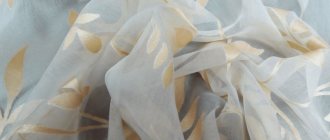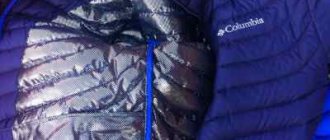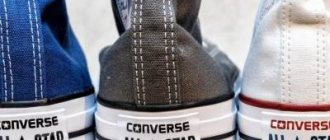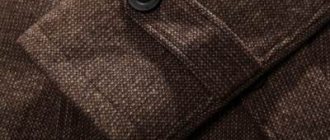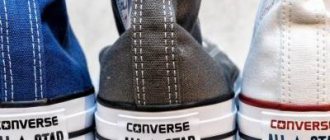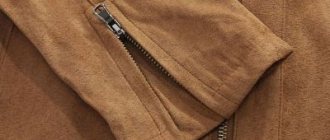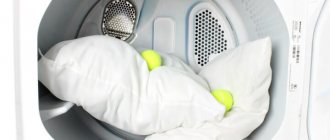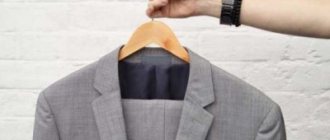The child is born, and along with the joy of motherhood, a stream of new responsibilities falls on the woman, among which is washing diapers.
How to do it correctly, what detergent to choose, do you need to iron?
Knowing how to wash reusable diapers (flannel, muslin, etc.) correctly will help you avoid many mistakes and make your mother’s daily work easier.
Preparing for washing
Before you send your diapers for washing, you need to prepare them properly:
- Thoroughly clean the fabric from any remaining food and feces.
- Sort diapers by color and type of material.
- Remove difficult, old stains.
Do not allow large amounts of dirty laundry to accumulate. The optimal washing mode is once a day.
Cleaning up baby feces
It is impossible to achieve an ideal result of cleanliness if the soiled diaper is not wiped down first.
If the fabric is stained with urine, wash it under running cool water, washing away traces of urine with laundry soap.
If the diaper is soiled with feces, then it is pre-washed, following a certain sequence of actions:
- The fabric is moistened with water, and the stain is washed with laundry soap.
- After five to ten minutes, the product is rinsed under running warm water and sent to the main wash.
What it is?
This fabric has the ability to retain heat, which is why even under Peter the Great, soldiers were given flannel in the army so that they could use it as foot wraps. Until the middle of the last century, warm leggings and underwear for both women and men were made from flannel. Another unusual use for fabric is as a wafer for piano hammers.
Baby diapers from this material began to be sewn in the first half of the 20th century. Since then, the fabric “does not age”, and such products for newborns are always in demand.
A big and convincing advantage lies in the ease of care of the material. Of course, over time, the diaper may become pilly, but before that, the child will definitely have time to outgrow not only the diaper, but also his first pair of shoes. The cost of flannel diapers is low and they are available. The disadvantage lies in the impossibility of constant and everyday use, because in hot weather pediatricians strongly do not recommend swaddling a child in flannel products.
The size of flannel products available for sale is usually 1x1.2 m. It is rare to find square diapers 1.2x1.2 m. Sizes such as 0.9x1.2 m and 0.75x1.1 m are also quite common.
Choice of product
The use of properly selected powder will help to avoid severe allergic reactions, dermatitis and other skin diseases in a newborn.
Diaper washing detergent must be purchased only in specialized stores or large supermarkets, where you can check the relevant product quality certificates.
The safest detergent for delicate baby skin meets the following criteria:
- does not contain aggressive chemicals (phosphates, bleaches);
- dissolves well in warm water;
- rinse completely in cold water;
- does not contain flavors or dyes.
Best choice for washing:
- liquid detergent for children's clothing;
- laundry soap (72%);
- baby soap (unlike adult soap, it contains a minimal amount of synthetic additives).
DIY powder
To make your own baby powder you will need only two ingredients: baking soda and laundry soap.
Everything is very simple:
- A bar of laundry soap is grated.
- Dissolve soap shavings in 200 ml of hot water.
- Heating the resulting soap solution on the stove, gradually add a soda solution to it (200 grams of dry powder per 100 ml of water).
- The resulting product is cooled and added to a special compartment of the washing machine.
How to do this correctly?
You can wash diapers either by hand or in a washing machine. The main thing is to strictly adhere to all the recommendations for proper washing. Read more about washing children's clothes here.
In the washing machine - at what temperature?
Machine washing saves mom time and effort. Most models of modern washing machines have a “baby wash” mode, in which the water is heated to the highest possible temperatures (60-90°C), and rinsing occurs in a larger volume of water.
If there is no such function, the wash is selected according to the type of fabric, and the double (or intensive) rinse mode is set.
The type of detergent is selected for washing children's clothes. The dosage of the powder is indicated by the manufacturer on the packaging (there is no need to exceed the recommended volume).
Washing takes place in the following sequence:
On the washing machine, set the mode for washing children's clothes, water temperature 60°C - 90°C, spin -800-900 rpm.- Liquid detergent is poured into a special compartment for washing children's clothes (as an option, you can use baby soap).
- The diapers are loaded into the drum and the “start” button is pressed.
- After washing, the diapers are hung out to dry in a well-ventilated place.
- Dried diapers must be ironed on both sides (the temperature is set according to the type of fabric).
To better remove detergents from the fabric, do a double (or even triple) rinse.
Hands
Washing by hand proceeds according to the following algorithm:
- Dissolve the selected detergent in a bowl of hot water (alternatively, you can use grated laundry soap).
- Prepared and sorted diapers (it is better to wash white fabrics separately from colored ones) are immersed in water and left for fifteen minutes.
- Afterwards, rub the diapers with your hands, rub especially dirty areas with laundry soap.
- Already washed diapers are rinsed in clean water two or three times.
Grandmothers' method of "boiling" can cause the fabric to appear gray or yellow.
Hydrogen peroxide will help bleach fabric. It is enough to dissolve two tablespoons of peroxide in water (5 liters), immerse the diapers in the resulting solution and leave them for three minutes, then rinse under running water.
Bleaching things
If you need to remove marks from greasy food or other stains, you can use stain removers for flannel. But choose brands without chlorine, especially for woolen fabric.
The gel from the Persil Universal line brightens well. Its use is practiced for manual and machine cleaning of products.
Home whitening techniques are popular. For undyed cotton items, use baking soda - 2 tbsp. l. Dissolve it in water - 6 liters, heated to 20˚C. Before washing, soak the items for two hours.
How to bleach flannel correctly
If yellow marks appear on the surface of flannel products, take ammonia with a liquid composition used for dishes. These components are measured in 50 ml. Combine with water warmed to 20 degrees - 250 ml and add baking soda - 3 tbsp. l. Stirring, bring the liquid until smooth. Spray with a spray bottle onto contaminated areas. After 10 minutes, wash by hand.
Features depending on material
There are several types of diapers:
Muslin diapers are light, thin, made from 100% cotton fibers, soft and very pleasant to the touch. They can be washed only on a delicate cycle or by hand. The water temperature does not exceed 40C (hot water will cause the product to shrink).- Flannel - soft, quite dense, with fleece on one side of the diaper. They are easy to care for. The main thing is to prevent the fabric from drying out. Wash flannel diapers at a water temperature of 60°C-90°C, using the washing mode for children's clothes.
When washing by hand, it is important to rinse the detergent well, as the powder remaining in the pile can cause irritation on the baby’s skin.
Application
When the baby has just appeared, provided that the parents swaddle him, warm flannel will serve well in the winter and during the off-season. You can swaddle your baby either directly in a warm diaper or using two types of products - calico and warm (on top). However, in the summer, when it is hot outside, it is better to avoid swaddling in a flannel diaper to avoid overheating of the child, excessive sweating and the development of various dermatological problems from diaper rash to atopic dermatitis.
This does not mean that flannel products will no longer be needed. They make excellent crib sheets. They are soft, pleasant to the baby's skin, and they are easy to wash and iron, which makes it easier for mom to change baby bedding.
From the first days and at any time of the year, flannel diaper fabric will be an indispensable assistant when bathing your baby. Many towels, even those released as baby towels, have a rather rough texture and therefore cannot be used for infants, especially for babies with sensitive skin prone to diaper rash, allergies and other skin ailments. Therefore, after bathing, it would be better to simply blot them (do not rub them!) with a flannel diaper. It perfectly absorbs moisture (especially double-sided flannelette) and does not injure children’s delicate skin.
You can always take such a product with you to a doctor’s appointment and place it on a couch or changing table to make the baby more comfortable during a pediatric medical examination. At home, such a diaper can be an excellent bedding for a children's massage table, on which the mother gives massage and gymnastics to the baby, and also carries out washing and morning exercise.
When the child learns to lie on his stomach and at the same time hold his head and look at everything that is within his reach, you can use a flannel product with beautiful and large patterns as the first developmental mat. Usually a 3-4 month old baby enjoys looking at what is depicted on the diaper on a white, blue or yellow background.
When the diaper finally loses its appearance (in a few years, because nothing lasts forever), it can be used to make soft absorbent cloths for household needs, cleaning, and the kitchen.
Do I need to process it immediately after purchase?
New diapers must be washed. There are several reasons for such actions:
- on a new product there are always particles of starch (added during production to give a better presentation), dust, and dyes;
- the diapers were lying in a warehouse, passing through a large number of people (cutters, seamstresses, loaders, sellers).
Read more about why and what items should be washed after purchase here.
The first wash is best done by hand. Algorithm of actions:
- Dissolve two or three tablespoons of liquid baby soap (or grated laundry soap) in a bowl of warm water.
- The diapers are soaked in the resulting solution for ten minutes.
- Afterwards, rub the fabric thoroughly with your hands.
- Washed items are rinsed in clean, cool water at least two to three times.
- Clean diapers are hung out to dry in the fresh air.
- Dried items are ironed on both sides (the temperature is set depending on the type of fabric) and placed in a closet (chest drawer) for storage.
Application
When the baby has just appeared, provided that the parents swaddle him, warm flannel will serve well in the winter and during the off-season. You can swaddle your baby either directly in a warm diaper or using two types of products - calico and warm (on top). However, in the summer, when it is hot outside, it is better to avoid swaddling in a flannel diaper to avoid overheating of the child, excessive sweating and the development of various dermatological problems from diaper rash to atopic dermatitis.
This does not mean that flannel products will no longer be needed. They make excellent crib sheets. They are soft, pleasant to the baby's skin, and they are easy to wash and iron, which makes it easier for mom to change baby bedding.
From the first days and at any time of the year, flannel diaper fabric will be an indispensable assistant when bathing your baby. Many towels, even those released as baby towels, have a rather rough texture and therefore cannot be used for infants, especially for babies with sensitive skin prone to diaper rash, allergies and other skin ailments. Therefore, after bathing, it would be better to simply blot them (do not rub them!) with a flannel diaper. It perfectly absorbs moisture (especially double-sided flannelette) and does not injure children’s delicate skin.
You can always take such a product with you to a doctor’s appointment and place it on a couch or changing table to make the baby more comfortable during a pediatric medical examination. At home, such a diaper can be an excellent bedding for a children's massage table, on which the mother gives massage and gymnastics to the baby, and also carries out washing and morning exercise.
When the child learns to lie on his stomach and at the same time hold his head and look at everything that is within his reach, you can use a flannel product with beautiful and large patterns as the first developmental mat. Usually a 3-4 month old baby enjoys looking at what is depicted on the diaper on a white, blue or yellow background.
When the diaper finally loses its appearance (in a few years, because nothing lasts forever), it can be used to make soft absorbent cloths for household needs, cleaning, and the kitchen.
How to dry?
To ensure that the fabric remains soft to the touch after washing, you must adhere to the basic drying rules:
Wet diapers are dried only in the fresh air, in a dark place. The use of automatic dryers is strictly prohibited.- Do not dry diapers on heating devices, near an open fire or in direct sunlight. Otherwise, the fabric becomes hard, overdried, and unpleasant for the baby’s delicate skin.
- Diapers are dried (and also stored) separately from adult clothing and bedding.
How to stroke?
Basic ironing rules:
- Iron the diapers on both sides.
- The temperature regime is selected individually for the type of fabric.
- In the first six months of the baby's life, an additional steam function is used during ironing.
Ironing helps not only to remove germs and bacteria remaining after washing, but also to get rid of wrinkles that can rub the baby’s delicate skin.
You can find out whether you need to iron children's clothes and why here.
General information
Many expectant mothers, being in an interesting situation, put off buying everything they need until the birth of the child. This is usually associated with various superstitions.
This approach is not very practical. After all, it’s not enough just to buy tiny diapers and vests; before the baby is born, they also need to be washed and ironed. And this is done for a number of reasons.
First of all, purchased items may contain starch (it is added to products to add shine), the use of which is extremely undesirable for children's items. In addition, the fabric went through several hands before it was formed into a cute onesie or romper. Then it was with the seller, the packer and who knows who else.
There is only one conclusion - it is imperative to wash a newborn’s clothes. In principle, all new things need to be washed, but when it comes to children’s clothes, there can be no deviations from this rule at all.
In the first weeks and months, a child’s skin is especially sensitive to external influences, and it is extremely important to avoid the occurrence of allergic reactions during this period. Of course, this reaction does not occur in all newborns, but it is better to be safe.
It is worth remembering that for the first contact with the baby’s skin, new things only made from natural fabrics are suitable. The detergent must also be special, but we will talk about this later.
You should prepare for the fact that there will be quite a lot of laundry and perhaps buy a little more clothes to prepare a supply.
After washing, all purchased clothes must be ironed on both sides. And this is not just a tribute to tradition - double-sided ironing (preferably with a steamer) will help kill all possible microbes.
Important Tips
It is strictly forbidden to wash children's clothes and underwear with adult dry powder. It contains phosphate compounds, surfactants, chlorine - substances that negatively affect delicate children's skin.- Diapers are washed separately from adult clothes and bed linen.
- It is prohibited to use bleaches, stain removers and fabric softeners when washing children's clothes.
- Dirty diapers are stored separately from adult clothing in a large box with holes for ventilation.
Brown laundry soap
For many years in a row, despite the variety of washing powders, many women prefer ordinary laundry soap. Due to the fact that it contains no substances that irritate the delicate skin of babies, its use completely eliminates the occurrence of allergies and allows you to solve the problem of how to whiten baby diapers. There are two ways to remove stains with soap:
- Fill a basin with hot water, soak things in it, and then rub them with soap. After 30-40 minutes, you will need to first wash them and then rinse them 2-3 times. The correct result is no stains and clean water after the last rinse.
- The second method is to use machine washable soap. It is necessary to grate half the block and pour 100 ml of water into the resulting shavings for 15-20 minutes. Next, you need to pour the mixture into the powder compartment, place dirty clothes and diapers in the drum and select the desired mode.
We suggest you read How to wash cotton so that it shrinks or stretches

